Arthur S. de Sena
A Deep-Unfolding Approach to RIS Phase Shift Optimization Via Transformer-Based Channel Prediction
Feb 25, 2025Abstract:Reconfigurable intelligent surfaces (RISs) have emerged as a promising solution that can provide dynamic control over the propagation of electromagnetic waves. The RIS technology is envisioned as a key enabler of sixth-generation networks by offering the ability to adaptively manipulate signal propagation through the smart configuration of its phase shift coefficients, thereby optimizing signal strength, coverage, and capacity. However, the realization of this technology's full potential hinges on the accurate acquisition of channel state information (CSI). In this paper, we propose an efficient CSI prediction framework for a RIS-assisted communication system based on the machine learning (ML) transformer architecture. Architectural modifications are introduced to the vanilla transformer for multivariate time series forecasting to achieve high prediction accuracy. The predicted channel coefficients are then used to optimize the RIS phase shifts. Simulation results present a comprehensive analysis of key performance metrics, including data rate and outage probability. Our results confirm the effectiveness of the proposed ML approach and demonstrate its superiority over other baseline ML-based CSI prediction schemes such as conventional deep neural networks and long short-term memory architectures, albeit at the cost of slightly increased complexity.
* Accepted for Scandinavian Simulation Society(SIMS) EUROSIM 2024
Uplink Rate Splitting Multiple Access with Imperfect Channel State Information and Interference Cancellation
Jan 31, 2025


Abstract:This article investigates the performance of uplink rate splitting multiple access (RSMA) in a two-user scenario, addressing an under-explored domain compared to its downlink counterpart. With the increasing demand for uplink communication in applications like the Internet-of-Things, it is essential to account for practical imperfections, such as inaccuracies in channel state information at the receiver (CSIR) and limitations in successive interference cancellation (SIC), to provide realistic assessments of system performance. Specifically, we derive closed-form expressions for the outage probability, throughput, and asymptotic outage behavior of uplink users, considering imperfect CSIR and SIC. We validate the accuracy of these derived expressions using Monte Carlo simulations. Our findings reveal that at low transmit power levels, imperfect CSIR significantly affects system performance more severely than SIC imperfections. However, as the transmit power increases, the impact of imperfect CSIR diminishes, while the influence of SIC imperfections becomes more pronounced. Moreover, we highlight the impact of the rate allocation factor on user performance. Finally, our comparison with non-orthogonal multiple access (NOMA) highlights the outage performance trade-offs between RSMA and NOMA. RSMA proves to be more effective in managing imperfect CSIR and enhances performance through strategic message splitting, resulting in more robust communication.
Beyond Diagonal RIS for Multi-Band Multi-Cell MIMO Networks: A Practical Frequency-Dependent Model and Performance Analysis
Jan 12, 2024Abstract:This paper delves into the unexplored frequency-dependent characteristics of beyond diagonal reconfigurable intelligent surfaces (BD-RISs). A generalized practical frequency-dependent reflection model is proposed as a fundamental framework for configuring fully-connected and group-connected RISs in a multi-band multi-base station (BS) multiple-input multiple-output (MIMO) network. Leveraging this practical model, multi-objective optimization strategies are formulated to maximize the received power at multiple users connected to different BSs, each operating under a distinct carrier frequency. By relying on matrix theory and exploiting the symmetric structure of the reflection matrices inherent to BD-RISs, closed-form relaxed solutions for the challenging optimization problems are derived. The ideal solutions are then combined with codebook-based approaches to configure the practical capacitance values for the BD-RISs. Simulation results reveal the frequency-dependent behaviors of different RIS architectures and demonstrate the effectiveness of the proposed schemes. Notably, BD-RISs exhibit superior resilience to frequency deviations compared to conventional single-connected RISs. Moreover, the proposed optimization approaches prove effective in enabling the targeted operation of BD-RISs across one or more carrier frequencies. The results also shed light on the potential for harmful interference in the absence of proper synchronization between RISs and adjacent BSs.
On the Sum Secrecy Rate of Multi-User Holographic MIMO Networks
Oct 22, 2023



Abstract:The emerging concept of extremely-large holographic multiple-input multiple-output (HMIMO), beneficial from compactly and densely packed cost-efficient radiating meta-atoms, has been demonstrated for enhanced degrees of freedom even in pure line-of-sight conditions, enabling tremendous multiplexing gain for the next-generation communication systems. Most of the reported works focus on energy and spectrum efficiency, path loss analyses, and channel modeling. The extension to secure communications remains unexplored. In this paper, we theoretically characterize the secrecy capacity of the HMIMO network with multiple legitimate users and one eavesdropper while taking into consideration artificial noise and max-min fairness. We formulate the power allocation (PA) problem and address it by following successive convex approximation and Taylor expansion. We further study the effect of fixed PA coefficients, imperfect channel state information, inter-element spacing, and the number of Eve's antennas on the sum secrecy rate. Simulation results show that significant performance gain with more than 100\% increment in the high signal-to-noise ratio (SNR) regime for the two-user case is obtained by exploiting adaptive/flexible PA compared to the case with fixed PA coefficients.
Semantic-Functional Communications in Cyber-Physical Systems
May 31, 2023Abstract:This paper explores the use of semantic knowledge inherent in the cyber-physical system (CPS) under study in order to minimize the use of explicit communication, which refers to the use of physical radio resources to transmit potentially informative data. It is assumed that the acquired data have a function in the system, usually related to its state estimation, which may trigger control actions. We propose that a semantic-functional approach can leverage the semantic-enabled implicit communication while guaranteeing that the system maintains functionality under the required performance. We illustrate the potential of this proposal through simulations of a swarm of drones jointly performing remote sensing in a given area. Our numerical results demonstrate that the proposed method offers the best design option regarding the ability to accomplish a previously established task -- remote sensing in the addressed case -- while minimising the use of radio resources by controlling the trade-offs that jointly determine the CPS performance and its effectiveness in the use of resources. In this sense, we establish a fundamental relationship between energy, communication, and functionality considering a given end application.
Unleashing 3D Connectivity in Beyond 5G Networks with Reconfigurable Intelligent Surfaces
May 08, 2023Abstract:Reconfigurable intelligent surfaces (RISs) bring various benefits to the current and upcoming wireless networks, including enhanced spectrum and energy efficiency, soft handover, transmission reliability, and even localization accuracy. These remarkable improvements result from the reconfigurability, programmability, and adaptation capabilities of RISs for fine-tuning radio propagation environments, which can be realized in a cost- and energy-efficient manner. In this paper, we focus on the upgrade of the existing fifth-generation (5G) cellular network with the introduction of an RIS owning a full-dimensional uniform planar array structure for unleashing advanced three-dimensional connectivity. The deployed RIS is exploited for serving unmanned aerial vehicles (UAVs) flying in the sky with ultra-high data rate, a challenging task to be achieved with conventional base stations (BSs) that are designed mainly to serve ground users. By taking into account the line-of-sight probability for the RIS-UAV and BS-UAV links, we formulate the average achievable rate, analyze the effect of environmental parameters, and make insightful performance comparisons. Simulation results show that the deployment of RISs can bring impressive gains and significantly outperform conventional RIS-free 5G networks.
RSMA for Dual-Polarized Massive MIMO Networks: A SIC-Free Approach
Dec 09, 2022Abstract:Aiming at overcoming practical issues of successive interference cancellation (SIC), this paper proposes a dual-polarized rate-splitting multiple access (RSMA) technique for a downlink massive multiple-input multiple-output (MIMO) network. By modeling the effects of polarization interference, an in-depth theoretical analysis is carried out, in which we derive tight closed-form approximations for the outage probabilities and ergodic sum-rates. Simulation results validate the accuracy of the theoretical analysis and confirm the effectiveness of the proposed approach. For instance, under low to moderate cross-polar interference, our results show that the proposed dual-polarized MIMO-RSMA strategy outperforms the single-polarized MIMO-RSMA counterpart for all considered levels of residual SIC error.
Rate-Splitting Multiple Access and its Interplay with Intelligent Reflecting Surfaces
May 24, 2022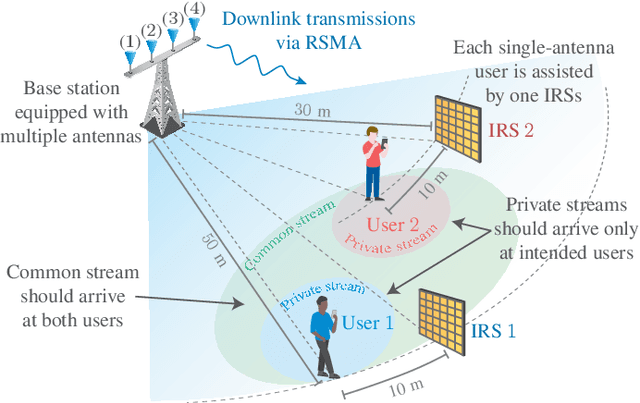
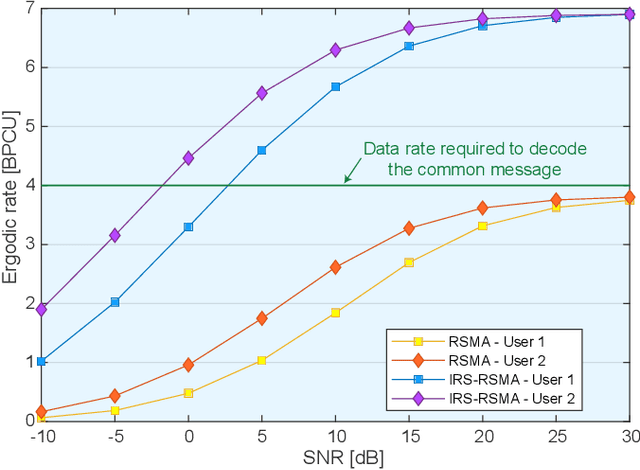
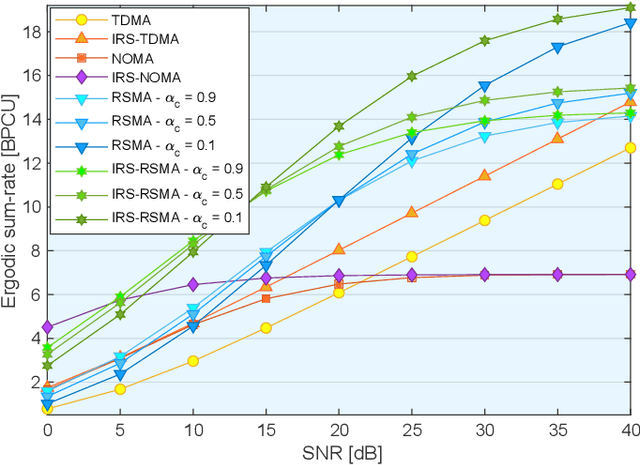
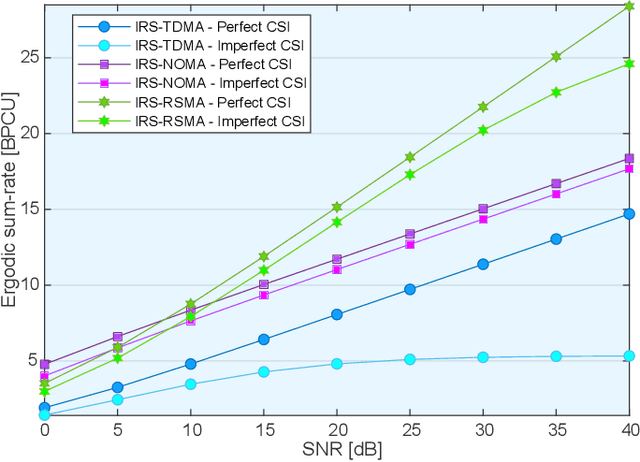
Abstract:Rate-splitting multiple access (RSMA) has recently appeared as a powerful technique for improving the downlink performance of multiple-input multiple-output (MIMO) systems. By flexibly managing interference, RSMA can deliver high spectral and energy efficiency, as well as robustness to imperfect channel state information (CSI). In another development, an intelligent reflecting surface (IRS) has emerged as a method to control the wireless environment through software-configurable, near-passive, sub-wavelength reflecting elements. This article presents the potential of synergy between IRS and RSMA. Three important improvements achievable by IRS-RSMA schemes are identified, supported by insightful numerical examples, and mapped to beyond-5G use cases, along with future research directions.
IRS-Assisted Massive MIMO-NOMA Networks with Polarization Diversity
May 27, 2021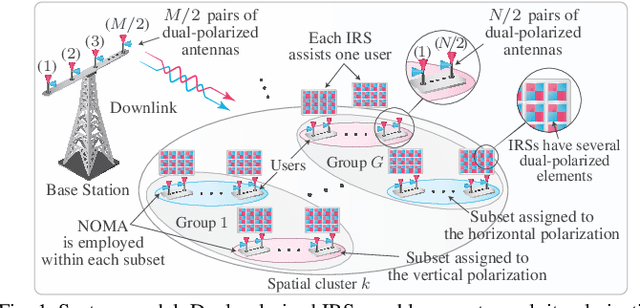
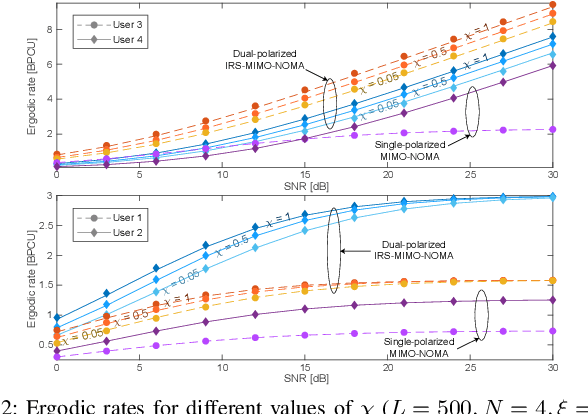
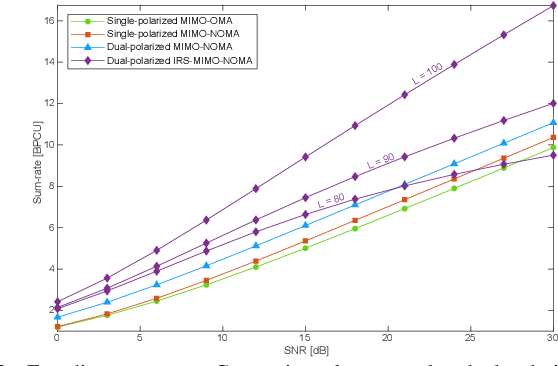
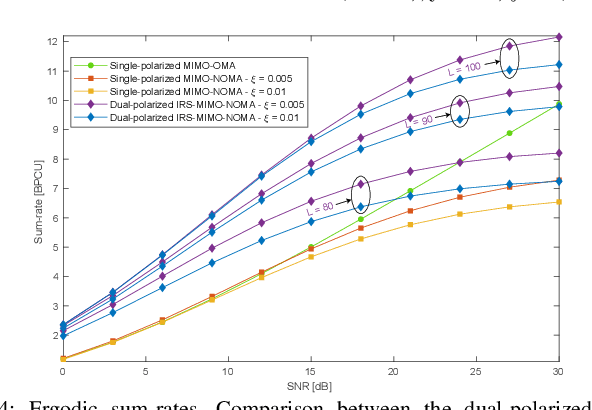
Abstract:In this paper, the appealing features of a dual-polarized intelligent reflecting surface (IRS) are exploited to improve the performance of dual-polarized massive multiple-input multiple-output (MIMO) with non-orthogonal multiple access (NOMA) under imperfect successive interference cancellation (SIC). By considering the downlink of a multi-cluster scenario, the IRSs assist the base station (BS) to multiplex subsets of users in the polarization domain. Our novel strategy alleviates the impact of imperfect SIC and enables users to exploit polarization diversity with near-zero inter-subset interference. Our results show that when the IRSs are large enough, the proposed scheme always outperforms conventional massive MIMO-NOMA and MIMO-OMA systems even if SIC error propagation is present. It is also confirmed that dual-polarized IRSs can make cross-polar transmissions beneficial to the users, allowing them to improve their performance through polarization diversity.
 Add to Chrome
Add to Chrome Add to Firefox
Add to Firefox Add to Edge
Add to Edge